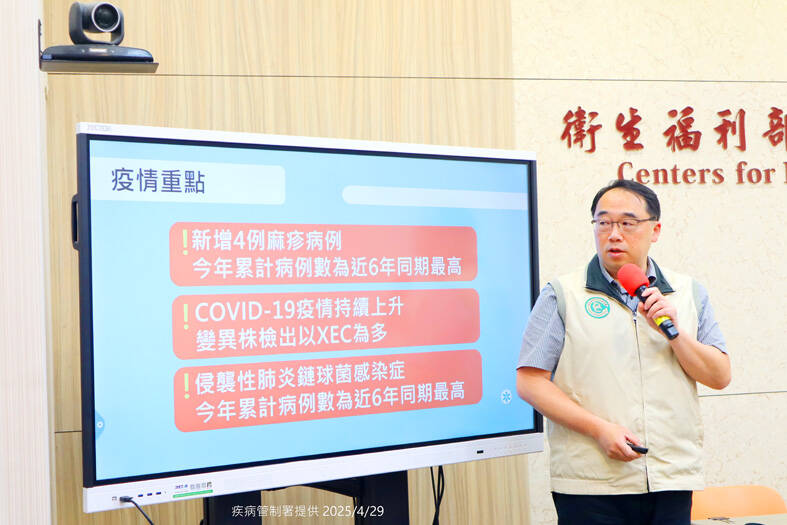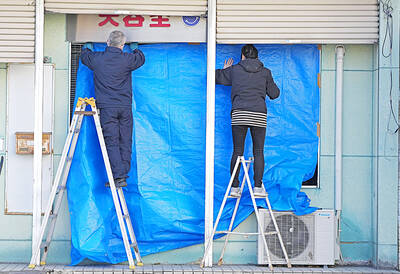COVID-19 infections have climbed for three consecutive weeks and are likely to reach another peak between next month and June, the Centers for Disease Control (CDC) said yesterday.
Weekly hospital visits for the disease increased by 19 percent from the previous week, CDC Epidemic Intelligence Center Director Guo Hung-wei (郭宏偉) said.
From Tuesday last week to yesterday, 21 cases of severe COVID-19 and seven deaths were confirmed, and from Sept. 1 last year to yesterday, there were 600 cases and 129 deaths, he said.

Photo courtesy of the Centers for Disease Control
From Oct. 1 last year to yesterday, 95.9 percent of the severe cases and 96.7 percent of the deaths did not get the latest vaccine, he added.
SARS-CoV-2 virus surveillance data from the past four weeks show that the XEC subvariant was the dominant strain among local cases, accounting for 54 percent, while the XDV.1 subvariant was the dominant variant among imported cases, accounting for 50 percent, Guo said.
CDC physician Lee Tsung-han (李宗翰) cited as an example of a severe case a young woman in her 20s residing in northern Taiwan who did not have underlying health conditions and who had received her last COVID-19 shot in 2022.
The woman had a fever for two days and developed soreness in the back and a cold sweat, Lee said.
She sought treatment at an emergency room, and was found to have a high white blood cell count and lower right lobe pneumonia, he said.
She tested positive for COVID-19, but negative for influenza, he said.
She also had an increased heartrate and an elevated creatine kinase level, so the doctors suspected she might have COVID-19 with pneumonia and myocarditis, Lee said, adding that she is still being treated in an intensive care unit.
CDC Deputy Director-General Philip Lo (羅一鈞) said that since the sixth wave of COVID-19 infections, mainly the Omicron variant, ended in August last year, COVID-19 activity remained low in the past eight months.
“However, this month, we have observed that hospital visits for COVID-19 have climbed steadily for three consecutive weeks, and severe cases and deaths are also increasing,” he said.
Hospital visits, severe cases and deaths last week all hit their highest levels this year, he said.
The CDC has determined that COVID-19 activity is rising, and is likely to reach its peak between next month and June, but it is hard to predict how high the case numbers would be at its peak, he said.
Lo advised the public to get vaccinated for better protection, and take a COVID-19 test if they develop suspected symptoms and tell a doctor the results when they seek medical attention.
There are still more than 3 million doses of government-funded COVID-19 vaccines, and at-home rapid COVID-19 test kits can be bought at many pharmacies, convenience stores, supermarkets and other retailers, Lo said, adding that the government has prepared more than a year’s supply of COVID-19 medications based on current trends.

Taiwanese were praised for their composure after a video filmed by Taiwanese tourists capturing the moment a magnitude 7.5 earthquake struck Japan’s Aomori Prefecture went viral on social media. The video shows a hotel room shaking violently amid Monday’s quake, with objects falling to the ground. Two Taiwanese began filming with their mobile phones, while two others held the sides of a TV to prevent it from falling. When the shaking stopped, the pair calmly took down the TV and laid it flat on a tatami mat, the video shows. The video also captured the group talking about the safety of their companions bathing

US climber Alex Honnold is to attempt to scale Taipei 101 without a rope and harness in a live Netflix special on Jan. 24, the streaming platform announced on Wednesday. Accounting for the time difference, the two-hour broadcast of Honnold’s climb, called Skyscraper Live, is to air on Jan. 23 in the US, Netflix said in a statement. Honnold, 40, was the first person ever to free solo climb the 900m El Capitan rock formation in Yosemite National Park — a feat that was recorded and later made into the 2018 documentary film Free Solo. Netflix previewed Skyscraper Live in October, after videos

Starting on Jan. 1, YouBike riders must have insurance to use the service, and a six-month trial of NT$5 coupons under certain conditions would be implemented to balance bike shortages, a joint statement from transportation departments across Taipei, New Taipei City and Taoyuan announced yesterday. The rental bike system operator said that coupons would be offered to riders to rent bikes from full stations, for riders who take out an electric-assisted bike from a full station, and for riders who return a bike to an empty station. All riders with YouBike accounts are automatically eligible for the program, and each membership account

A classified Pentagon-produced, multiyear assessment — the Overmatch brief — highlighted unreported Chinese capabilities to destroy US military assets and identified US supply chain choke points, painting a disturbing picture of waning US military might, a New York Times editorial published on Monday said. US Secretary of Defense Pete Hegseth’s comments in November last year that “we lose every time” in Pentagon-conducted war games pitting the US against China further highlighted the uncertainty about the US’ capability to intervene in the event of a Chinese invasion of Taiwan. “It shows the Pentagon’s overreliance on expensive, vulnerable weapons as adversaries field cheap, technologically